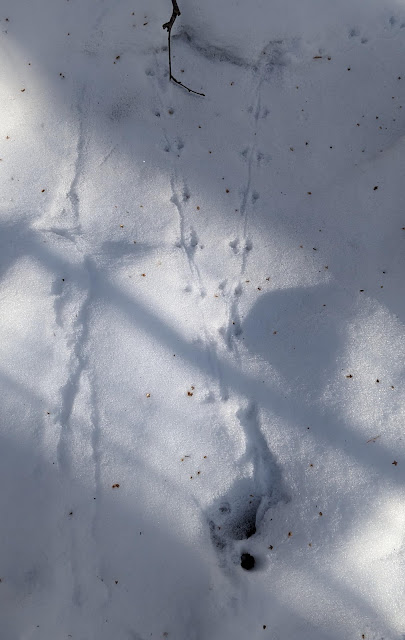It's not looking much like the last day of December. Instead of skating and ice fishing taking place on the lake, I was out in a boat on Friday.
The mission was to rescue some of the dock items that floated away during last week's flood, and the job was greatly facilitated by the fact that almost all the ice on the lake has cleared out. An enthusiastic team joined forces to pull, row, and paddle the wayward docks back to their proper winter homes. It went off without a hitch, and it once again shows how a close-knit, supportive New England community comes together to help each other.
The lake has dropped about a foot since last week but is still seven inches above normal water level. The drop is evident by sheets of ice that collapsed around the shore line as the water receded.
 |
| Ice hung up on shore shows how much the lake has dropped. |
Now to the birth of a pond. I think we're about to have an opportunity to witness the creation of a new pond right here in Meredith. It's not a totally new pond, but rather the restoration of a prior wetland that was abandoned years ago. On a recent work day repairing storm erosion in the Hamlin Town Forest, I noticed a few trees that had just been harvested by beavers.
Investigating further I discovered it wasn't a few trees, but many.
 |
| Many stumps in an area being cleared by beavers. |
And then I found a new dam that had appeared since the last time I was there and is surely where much of that felled wood ended up.
 |
| This nascent dam was overtopped on the left by the rain, but held firm nonetheless. |
What is presently a large wet meadow with a stream running through it, was at one point a beaver pond. But many years ago, probably after the resident beavers had consumed all the desirable trees within easy reach from the safety of the pond, they moved on to greener pastures. Over time the dam fell into disrepair and the pond slowly drained away. Today, the trees around the pond have regrown enough that a new generation of beavers has returned with the intent of restoring the old estate to a vibrant family homestead.
I went to google earth to look at historical photos of the pond dating back to 1984. In those 60 years it has gone through two cycles of meadow to pond. The last time there was open water in the pond was 2005, almost 20 years ago - long enough for the beaver's preferred size of tree to have regrown.
It's in such an accessible location that anyone interested in watching what happens over the next few years can easily do so. The meadow is just to the left as you leave the trailhead and cross the first bridge. 100 yards down the Yellow Trail, a short spur leads to a view point (binocular icon) where one can see a good portion of the meadow. I'll report on changes here, but there's nothing like watching it develop it first hand over the years.
While I was out on Lake Wicwas this week I took note of a huge food store that beavers living in the largest lodge on the lake have amassed for the winter.
 |
| The pantry is right next to the lodge for safe and easy winter access. |
There must be a healthy population of beavers living in that home.
That's the goods news from the lake, but there's sad news also, and you may want to skip this next section as it relates to the demise of one of my favorite wild animals.
Right at the dam, where's there's just a narrow strip of road that separates Lake Wicwas from the wetland below the dam, I found an animal dead beside the road. It was a river otter, one of the most interesting and fun-loving animals in New Hampshire.
These are quick animals, and no doubt had its demise due to bad timing as it leaped up out of one water body to cross over to the other. Perhaps otters usually travel under the road through the dam spillway, but the high flow over the dam might have required an overland trip for this unfortunate otter. It looked to me to be a young otter as it's not quite three feet long which is the lower end of the three foot to four-and-a-half foot length of a fully grown river otter.
A mature otter weighs between 15 and 30 pounds, and this animal weighted well below 30 pounds. Before giving it a proper burial I took advantage of the sad situation to observe some of the detail on these animals. Otters have five well-developed toes on each foot, with the hind foot somewhat larger than the front.
 |
| Front foot with well defined claws, toe and heel pads. |
All four feet are webbed which helps them be such good swimmers and hunters. Otters have many whiskers on their nose which they use to sense motion of fish both at night and during the day in deep, dark areas of the lake. They can swim under water for up to a quarter of a mile. It's their great efficiency in hunting that supposedly provides them so much time for play.
To leave on a happy note, I'll share a video of several otters having a great time in the snow. This is from Washington State, but it could just as well be any lake with otters here in New Hampshire.











































